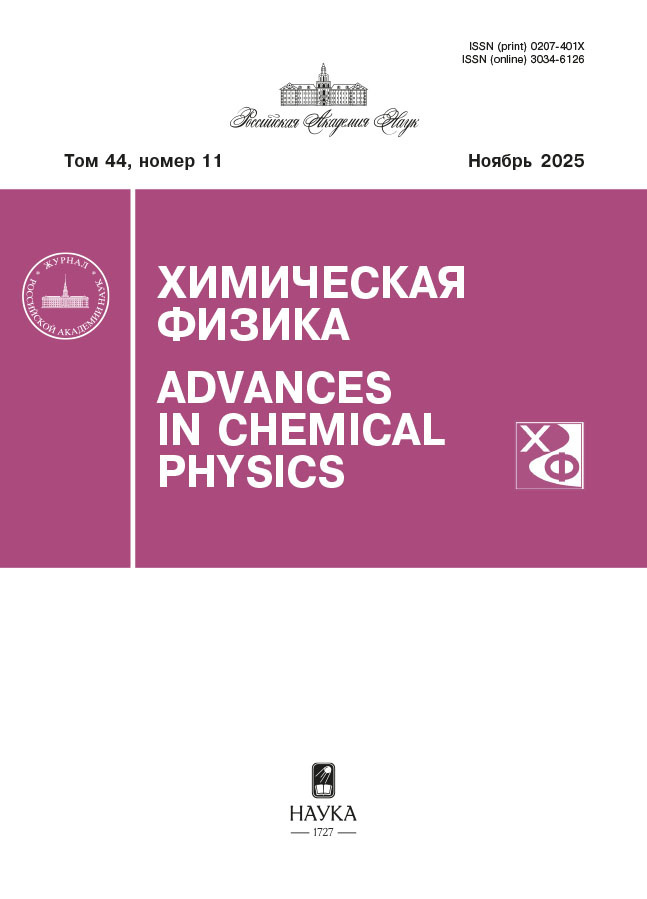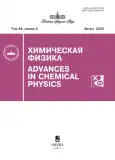Kinetic features of non-thermal plasma conversion of propane-air mixture at high pressure
- Authors: Filimonova E.A.1, Selivonin I.V.1, Moralev I.A.1, Dobrovolskaya A.S.1
-
Affiliations:
- Joint Institute for High Temperatures, Russian Academy of Sciences
- Issue: Vol 44, No 8 (2025)
- Pages: 64-80
- Section: Combustion, explosion and shock waves
- URL: https://gynecology.orscience.ru/0207-401X/article/view/689003
- DOI: https://doi.org/10.31857/S0207401X25080071
- ID: 689003
Cite item
Abstract
The paper presents the results of modeling the conversion of a lean non-combustible propane-air mixture with initiation by a high-frequency corona discharge at a pressure of 5 bar and an initial temperature of 300 K for different equivalence ratios. The discharge creates non-thermal plasma in filament channels. Experiments on the development of such a discharge in air for different conditions were carried out. At pressures of 1 and 2 bar, the discharge has a complex morphology with branching of discharge filaments. At pressures above 3 bar, the glow region has the shape of a straight spoke. The paper presents a kinetic analysis of the conversion. The key component for propane decomposition is the O atom produced in the discharge as a result of O2 dissociation by direct electron impact and excited N2 molecules. In the afterglow, after completion of discharge, the source of the O atom is the reactions of ozone decomposition with N2 and O2. For the formation of NO, it is necessary to take into account the production of N atoms in the excited and ground states. Intermediate oxidized hydrocarbons play a major role in increasing the concentrations of C3H6, C2H4, and CO over time. The decomposition of O3 occurs to a greater extent in a cycle involving NO3. The heating of the discharge-activated zone did not exceed 600 K. The composition of the conversion products obtained as a result of modeling was compared with known experimental literature data.
Full Text
About the authors
E. A. Filimonova
Joint Institute for High Temperatures, Russian Academy of Sciences
Author for correspondence.
Email: helfil@mail.ru
Russian Federation, Moscow
I. V. Selivonin
Joint Institute for High Temperatures, Russian Academy of Sciences
Email: helfil@mail.ru
Russian Federation, Moscow
I. A. Moralev
Joint Institute for High Temperatures, Russian Academy of Sciences
Email: helfil@mail.ru
Russian Federation, Moscow
A. S. Dobrovolskaya
Joint Institute for High Temperatures, Russian Academy of Sciences
Email: helfil@mail.ru
Russian Federation, Moscow
References
- Bellenoue M., Labuda S., Ruttun B., Sotton J. // Combust. Scien. Technol. 2007. V. 179. P. 477.
- Reitz R.D. // Combust. Flame. 2013. V. 160. P. 1. http://dx.doi.org/10.1016/j.combustflame.2012.11.002
- Discepoli G., Cruccolini V., Ricci F. et al. // Appl. Energy. 2020. V. 263. 114617. https://doi.org/10.1016/j.apenergy.2020.114617
- Hampe C., Bertsch M., Beck K.W. et al. // SAE. 2013. 2013-32-9144.
- Burrows J. and Mixell K. // Ignition Systems for Gasoline Engines / Eds. Günther M., Sens M. Switzerland: Inter. Publ. Springer, 2017. P. 268. https://doi.org/10.1007/978-3-319-45504-4_17
- Schenk A., Rixecker G., Bohne S. Third Laser Ignition Conference (LIC). US, 2015. Paper W4A.4.
- Xu D.A., Lacoste D.A., Laux C.O. // Plasma Chem. Plasma Proces. 2016. V. 36. P. 309. https://doi.org/10.1007/s11090-015-9680-3
- Ju Y., Sun W. // Progr. Energy Combust. Scien. 2015. V. 48. P. 21. http://dx.doi.org/10.1016/j.pecs.2014.12.002
- Filimonova E., Bocharov A. Bityurin V. // Fuel. 2018. V. 228. P. 309. https://doi.org/10.1016/j.fuel.2018.04.124
- Filimonova E.A., Bocharov A.N., Dobrovolskaya A.S., Bityurin V.A. // Plasma Chem. Plasma Proces. 2019. V. 39. № 3. P. 683. https://doi.org/10.1007/s11090-019-09964-x
- Tsolas N., Lee J.G., Yetter R.A. // Philosoph. Transact. Royal Soc. A. 2015. V. 373. 20140344. http://dx.doi.org/10.1098/rsta.2014.0344
- Tsolas N., Yetter R.A. // Combust. Flame. 2017. V. 176. P. 534. http://dx.doi.org/10.1016/j.combustflame.2016.10.022
- Tsolas N., Yetter R.A., Adamovich I.V. // Ibid. 2017. V. 176. P. 462. http://dx.doi.org/10.1016/j.combustflame.2016.10.023
- Filimonova E.A. // J. Phys. D: Appl. Phys. 2015. V. 48. 015201. https://doi.org/10.1088/0022-3727/48/1/015201
- Ban Y., Zhong Sh., Zhu J., Zhang F. // Fuel. 2023. V. 339. 127353. https://doi.org/10.1016/j.fuel.2022.127353
- Wang L., Yu X., Zheng M. // IEEE Transact. Plasma Scien. 2021. V. 49. No. 1. P. 326. https://doi.org/10.1109/TPS.2020.3041635
- Yu X., Wang L., Yu S., Wang M., Zheng M. // Plasma Sources Sci. Technol. 2022. V. 31. 055004. https://doi.org/10.1088/1361-6595/ac5f21
- Pipa A.V., Koskulics J., Brandenburg R., Hoder T. // Rev. Sci. Instrum. 2012. V. 83. № 11. P. 115112. https://doi.org/10.1063/1.4767637
- Pashin M.M., Lisov N.Yu. // Electricity. 2011. № 1. P. 21. [In Russian].
- Kriegseis J., Möller B., Grundmann S., Tropea C. // J. Electrostat. 2011. V. 69. № 4. P. 302. http://dx.doi.org/10.1016/j.elstat.2011.04.007
- Lisov N.Yu. // Electricity. 2016. № 10. P. 28. [In Russian].
- Orlov D.M., Corke T.C. // Proc. 44th AIAA Aerospace Sci. Meeting and Exhibit. Reno, Nevada: American Institute of Aeronautics and Astronautics, 2006. P. AIAA 2006-1206. https://doi.org/10.2514/6.2006-1206
- Filimonova E.A., Dobrovolskaya A.S., Bocharov A.N., Bityurin V.A., Naidis G.V. // Combust. Flame. 2020. V. 215. P. 401. https://doi.org/10.1016/j.combustflame.2020.01.029
- Filimonova E.A., Dobrovolskaya A.S. // High Temperature. 2023. V. 61. № 3. P. 311. https://doi.org/ 10.1134/S0018151X23030082
- Auzas F., Tardiveau P., Puech P., Makarov M, Agneray A. // J. Phys. D: Appl. Phys. 2010. V. 43. 495204. https://doi.org/10.1088/0022-3727/43/49/495204
- Hagelaar G.J.M., Pitchford L.C. // Plasma Sources Sci. Technol. 2005. V. 14. P. 722.
- Babaeva N.Yu., Naidis G.V. // J. Phys. D: Appl. Phys. 1996. V. 29. P. 2423.
- Filimonova E.A., Dobrovolskaya A.S. // Russ. J. Phys. Chem. B. 2023. V. 17. № 6. P. 1285. https://doi.org/ 10.1134/S1990793123060167
- Filimonova E.A., Kim Y., Hong S.H., Song Y.H. // J. Phys. D: Appl. Phys. 2002. V. 35. P. 2795.
- Zheleznyak M.B., Filimonova E.A. // High Temperature. 1998. V. 36. № 4. P. 533.
- Herron J.T. // J. Phys. Chem. Ref. Data. 1999. V. 28. № 5. P. 1453.
Supplementary files














